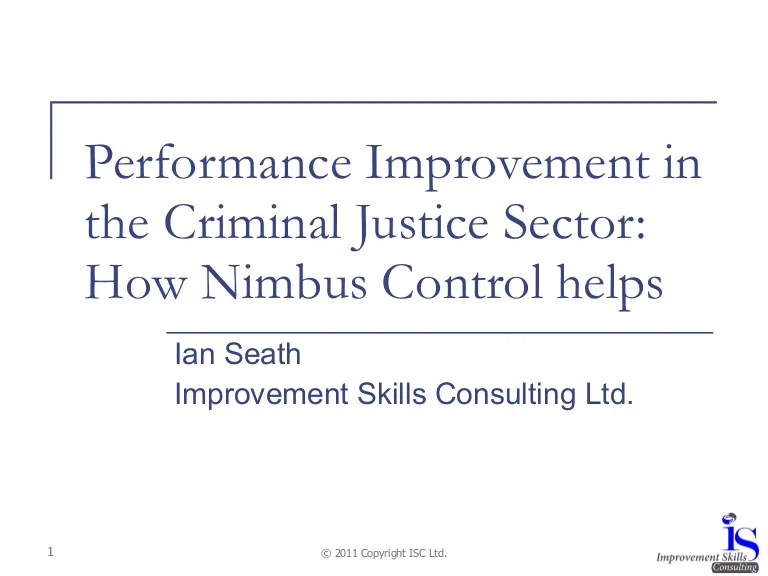Performance improvement in Criminal Justice using Nimbus Control
Description
Two case study examples showing how Nimbus Control process software has been used to improve performance in the Criminal Justice sector.
Transcript
Performance Improvement in the Criminal Justice Sector: How Nimbus Control helps Ian Seath Improvement Skills Consulting Ltd. © 2011 Copyright ISC Ltd. Agenda
- How we use Nimbus Control
- Process Improvement projects
- Case study examples
- Procurement: cost savings
- Attrition: cycle-time reductions
- Success factors
- Benefits of using Nimbus Control
- Capture:
- Live mapping workshops
- Walk-through
- Improvement:
- Understand today’s process
- Quantitatively – using Control’s “data capabilities”
- Qualitatively – using our knowledge of what “good” looks like
- Design and implement changes
- We typically use a process improvement project approach to give some structure, focus and to assist with effective management of change
- DMAIC
- Define – process capture
- Measure – volumes, costs, times, delays, re-work (RFT probabilities)
- Analyse – activity costing, FTE analysis
- Improve – process capture, scenarios
- Control – deployment of maps and documents, process metrics
- The primary objective was to streamline the end-to-end purchasing process to free up time to support the Contracts and Facility Management Function
- Identified Problems
- Increased volume of purchase orders (up by 30% but no idea why)
- A strong perception that many “big ticket items” where not going through the purchase order process (backed up by the fact they never had a grip on spend)
- Had introduced “Oracle” centrally and were looking to roll-out to all admin clerks
- Had been raised in a recent audit as an area to improve
- It cost £3,000 per year to process mobile ‘phone bills (excluding the time it took managers to scrutinise bills)
- Solution: change the policy on mobile ‘phone use and get one single invoice
- The complexity of the “catalogue system” was only ever going to increase time and coding error rate (39 different types of black pen)
- Solution: Reduce the number of order lines and pre-approve items
- The updating of the catalogue coding process was chaotic (3 month time-lag led to orders for a new stapler delivering a new pair of stepladders)
- Solution: Work with the supplier to an agreed “changeover” date
- 100% of orders were routed through the Purchasing Managers (time and delay) and had already been authorised by Unit Admin Manager
- Solution : Change system to allow Purchasing Clerk to authorise up to a certain level and free up managers’ time to pre-authorise, quality assure and manage control “catalogue” system
- Some invoices were arriving with no Purchase Order leading to issues around budget control and lots of time wasted trying to find purchaser
- Solution : Inform suppliers that no invoice would be paid without a Purchase Order number
- The primary objectives were to map the processes and analyse the performance data applied to cases from charge to sentence in the Central Area Command Unit, to include Magistrates’ and Crown Court cases.
- The purpose was to identify practices that contribute to Cracked and Ineffective trials, and to identify actions that would lead to improved performance.
- Ineffective Trial = On the trial date, expected progress is not made due to action or inaction by one or more of the prosecution, the defence or the court and a further listing for trial is required.
- Cracked Trial = Cracked trials are those which result in a guilty plea at the last minute. The guilty plea may be to the whole indictment or to only part of it or even to an alternative count. A cracked trial therefore requires no further trial time.
- 45% of ineffective trials are a prosecution failure
- 27% of ineffective trials are lack of prosecution witnesses
- 18% of all ineffective trials are caused by the defendant being absent
- 75% of all trials that are vacated then go on to become Cracked or Ineffective (of the total number of trials in the twelve month period, 69% Crack or become Ineffective)
- 38% of all vacated trials that then crack are caused by the Prosecution team either not having witnesses or the Prosecution team ending the case
- As the number of trials increases, the rate of cracking increases, suggesting that workload within the Prosecution team impacts the outcome of trials
- Identify the right projects (processes) to work on
- Think process, not function – end-to-end & customer-driven
- Do it with the process experts – the staff who operate the processes
- Measure the right things – defined by your improvement objectives
- Understand what a “good” process looks like – Lean thinking helps
- Management of change – applying sound principles in ways that work for the organisation (e.g. influenced by sector [private/public], industry [manufacturing/service])
- Speed of capture
- Easier analysis
- Rapid testing of improvement scenarios
- Confidence in deployment
